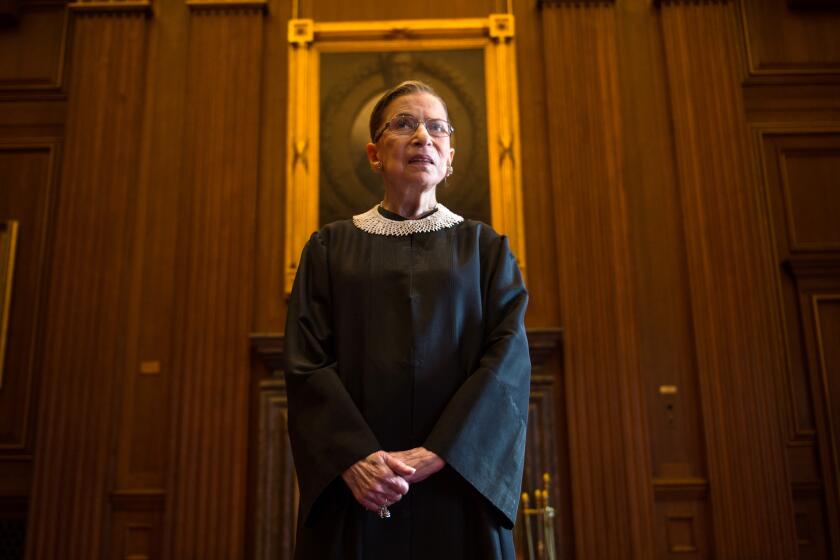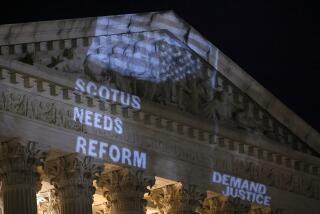Q&A: What happens now with the Supreme Court?

WASHINGTON â The death of Supreme Court Justice Ruth Bader Ginsburg sets the stage for a monumental political fight in the Senate over whether President Trump and Senate Majority Leader Mitch McConnell can confirm a conservative jurist to replace her even as voters in some states are already casting ballots.
Hereâs a look at what to expect in the coming months.
Can President Trump and Senate Republicans nominate and confirm another Supreme Court justice so close before the election?
Legally they can, and McConnell (R-Ky.) has already said he intends to have a vote although he did not say when it would be held. There isnât much time to do so before election day, but it wouldnât be the shortest confirmation process in recent history. Only 19 days elapsed between the announcement of Justice John Paul Stevensâ nomination and a Senate vote in 1975. Ginsburgâs confirmation took 42 days and Sandra Day OâConnorâs 33. On average, a confirmation takes nearly 70 days.
But Democrats say rushing the process for such an important position would be unfair. In the end, all McConnell will need is 50 votes in the Senate, and there are 53 Republicans.
Wait, didnât McConnell refuse to hold a hearing for Obamaâs Supreme Court nominee because it was an election year?
Yes, as Senate leader, he had the power to deny a confirmation hearing for Judge Merrick Garland. After conservative Justice Antonin Scalia died in February 2016, McConnell said the âAmerican people should have a voiceâ in deciding on the new justice. That seat was ultimately filled by Trump, who selected Neil M. Gorsuch.
More recently, McConnell has said he would move to fill a Supreme Court vacancy prior to the 2020 election because, he argues, it is a different situation today because the president and the Senate majority party are in agreement, which was not the case in 2016.
Democrats insist President Trump hold off on filling the Supreme Court vacancy left by the death of Ruth Bader Ginsburg. Republicans offer no commitment.
What if they canât do it by Nov. 3. Can they do it during the lame-duck session?
Yes, though that would be exceedingly rare in modern times.
But McConnell could have reason to hold off on the vote until after election day. A contentious Supreme Court vote could significantly hurt Sen. Susan Collinsâ reelection battle in Maine. Democrats are frustrated that she supported Trumpâs last nominee, Brett M. Kavanaugh. Although there are risks: If Democrats win the White House or control of the Senate, McConnell would face even more pressure to not confirm a nominee.
So is it settled? Theyâll fill the seat?
Not necessarily. First of all, time is short and Democrats are likely to delay as much as possible. Also it remains unclear whether McConnell will have the support of all 53 GOP senators.
Assuming all Democrats vote against confirmation, McConnell would need at least 50 Republicans since Vice President Mike Pence, as president of the Senate, could break any tie.
But already Sen. Lisa Murkowski (R-Alaska) has said she would not vote to confirm a hypothetical nominee. âI would not vote to confirm a Supreme Court nominee. We are 50-some days away from an election,â she told Alaska Public Radio Friday â before Ginsburgâs death was announced.
Sen. Collins may also have concerns. Even Sen. Lindsay Graham (R-S.C.), chairman of the Judiciary Committee â who is also facing a tight reelection â said flatly in 2018 that if a vacancy occurred during the 2020 election year, he would not hold a confirmation hearing, though itâs possible he will change that position now.
How important is this seat?
Critical. The bench comprised five conservative-leaning jurists and four liberal-leaning jurists.
Replacing Ginsburg, an icon of the liberal left, with a conservative would mean the court is more likely to overturn Roe vs. Wade, which guarantees the right to abortion, and the Affordable Care Act, the Obama-era healthcare law Republicans have vowed to kill. It could cement the benchâs rightward tilt for generations.
And there are potential consequences in the very short term as the country barrels toward an expected contested election. The Supreme Court is the final arbiter in an undecided presidential election.
Whom is Trump considering?
The leading candidate to replace Ginsburg is Judge Amy Coney Barrett, a former law clerk for Scalia and a longtime law professor at Notre Dame University. Trump nominated her to a seat on the 7th Circuit Court of Appeals in Chicago and interviewed her when he was in the process of selecting jurists to replace Scalia and Justice Anthony M. Kennedy. White House lawyers said then they expected Judge Barrett would be nominated if Justice Ginsburg died in office.
Times staff writer David Savage in Washington contributed to this report.
More to Read
Get the L.A. Times Politics newsletter
Deeply reported insights into legislation, politics and policy from Sacramento, Washington and beyond. In your inbox three times per week.
You may occasionally receive promotional content from the Los Angeles Times.













